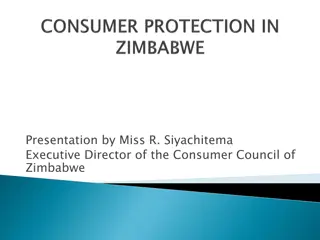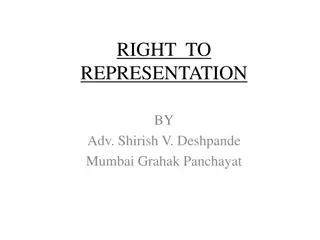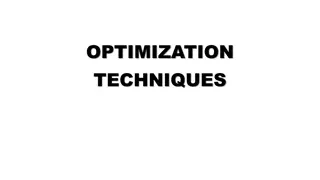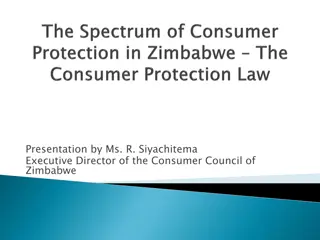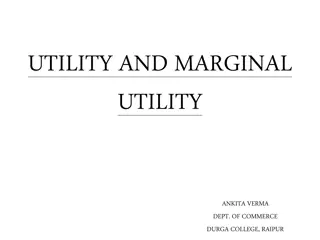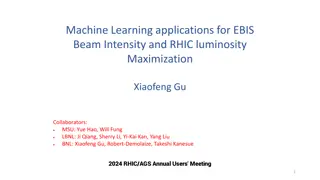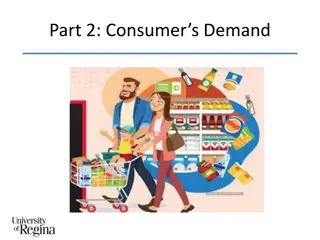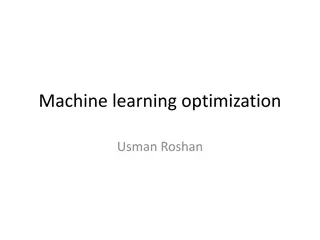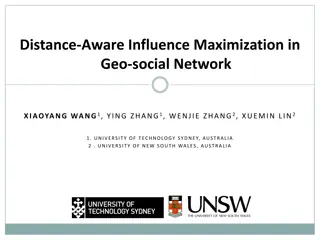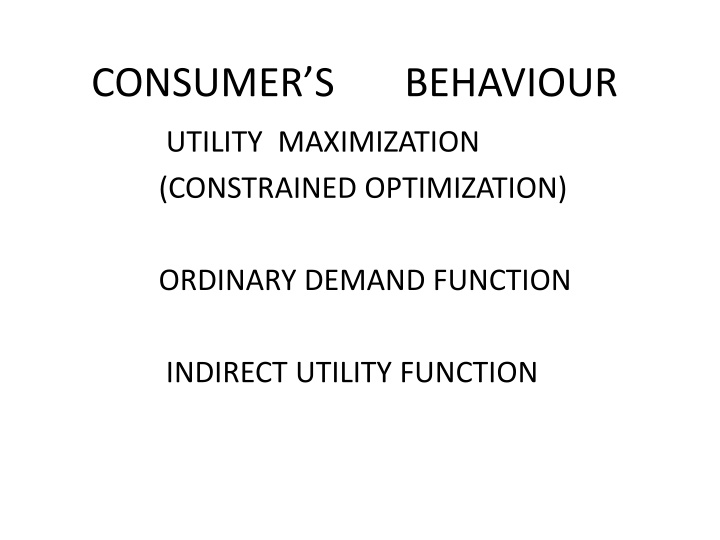
Consumer Behavior - Utility Maximization in Constrained Optimization
Analyzing consumer behavior through utility maximization, constrained optimization, ordinary demand functions, and indirect utility functions to determine optimal consumption levels and understand the Marshallian demand functions. Explore the implications of Lagrangian equations, second order conditions, and indirect utility functions in economic decision-making.
Uploaded on | 1 Views
Download Presentation

Please find below an Image/Link to download the presentation.
The content on the website is provided AS IS for your information and personal use only. It may not be sold, licensed, or shared on other websites without obtaining consent from the author. If you encounter any issues during the download, it is possible that the publisher has removed the file from their server.
You are allowed to download the files provided on this website for personal or commercial use, subject to the condition that they are used lawfully. All files are the property of their respective owners.
The content on the website is provided AS IS for your information and personal use only. It may not be sold, licensed, or shared on other websites without obtaining consent from the author.
E N D
Presentation Transcript
CONSUMERS BEHAVIOUR UTILITY MAXIMIZATION (CONSTRAINED OPTIMIZATION) ORDINARY DEMAND FUNCTION INDIRECT UTILITY FUNCTION
UTILITY MAXIMIZATION The utility function u = u( x1 , x2 ,.........., xn) ui 0 The budget constraint pixi = M pi = price of i th commodity M = Money Income pi , M are given to the consumer
Two commodity utility function u = u(x1 , x2 ) the budget constraint p1x1+ p2x2=M Maximize u = u(x1 , x2 ) ........ 1 Subject to p1x1+ p2x2=M ......... 2
A necessary consequence of this behaviour is that the first partials of the following Lagrangian equal to zero: L = u = u(x1 , x2 ) + (M- p1x1+ p2x2) ... 3 where is the Lagrange multiplier. Hence L1 = u1- p1 = 0 .......... 3a L2 = u2- p2 = 0 ......... 3b L = M- p1x1+ p2x2=0 ........ 3c
The sufficient second order condition for this constrained maximum is that the Bordered Hessian determinant of the second partials of L be positive: L11 L12L1 D = L21 L22 L2 = u21 L 1 L 2 L A positive D means the strict convexity of the (downward- sloping) IC at the point of tangency. u11 u12 -p1 u22-p2 0 - p1 -p2 0 ... 4
MARSHALLIAN DEMAND FUNCTION Solving 3a,3b,3c (i.e. The FOCs) yields the optimal values of the 3 unknowns : x1= x1M(p1 ,p2, M) ......... 5a x2= x2M(p1 ,p2, M) ......... 5b = M(p1 ,p2, M) ......... 5c 5a and 5b indicate the chosen levels of consumption for any given set of prices and money income.These are referred to as the Money-income-held-constant demand curves and also as Marshallian Demand Functions.
INDIRECT UTILITY FUNCTION The Marshallian Demand functions are also known as Ordinary Demand Functions. As 5a, and 5b are substituted into 1 obtains the Indirect Utility Function. u*(p1,p2, M) = u [x1M(p1,p2, M) , x2M(p1,p2, M) ] ............. 6 u*is a function of the parameters: prices and money income. 6 gives the maximum value of utility for any given prices and money income.
INTERPRETATION OF From the First order relations M = u1/ p1 = u2/ p2 From 3a and 3b, u1x1M + u2x2M = M(p1x1M+ p1x2M) = MM M= u1x1M + u2x2M /M The same marginal utility per unit of money must occur when the incremental expenditure is spread out over both commodities, as when it is spent at either margin.







